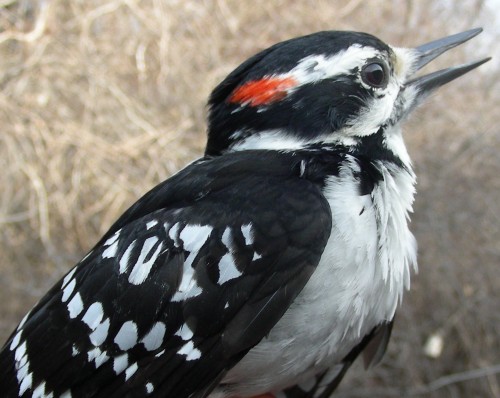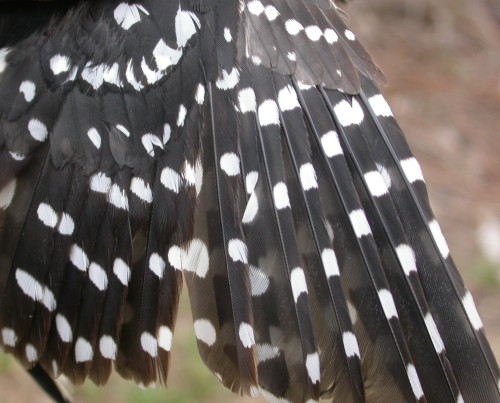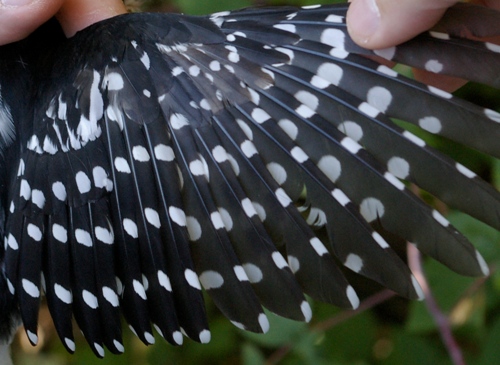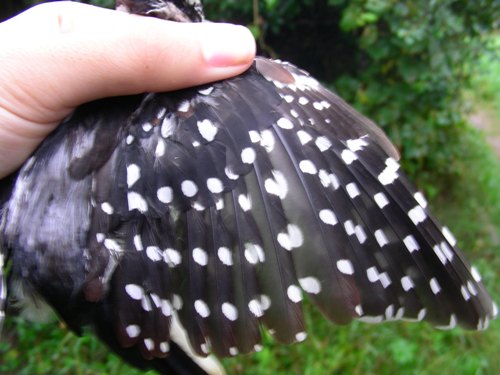|
McGILL BIRD OBSERVATORY |
||||||||||||||||||||||||||||||||||||||||||||||||||||||||||||||||||||||||||||||||||||||||||||||||||||||||||||||||
Seasonal status at MBO:
Ageing and sexing details:
Primary coverts are
an irregular mix of black (fresh), brown, and very pale brown (worn)
feathers OR are uniformly black / dark brown (only marginally paler than
wing).
Tails are not terribly useful for ageing or sexing woodpeckers, though can help differentiate between Downy and Hairy Woodpeckers. The Downy Woodpecker has black in the outer rectrix while the Hairy rarely does.
The crown does not have a red patch, but may have 1-2 red feathers, and the iris is a deep red. It is occasionally possible to age an ATY with isolated retained juvenal feathers or 3 generations of primary coverts as a 4Y bird.
Primary coverts are an irregular mix of black (fresh), brown, and very pale brown (worn) feathers OR are uniformly black / dark brown (only marginally paler than wing).
Tails are not terribly useful for ageing or sexing woodpeckers, though can help differentiate between Downy and Hairy Woodpeckers. The Downy Woodpecker has black in the outer rectrix while the Hairy rarely does.
Crown has a red patch.
The outer few primary coverts are replaced (black). All other retained primary coverts are pale brown. It is possible that a few extremely faded juvenal secondaries may be retained (s1-s5). Some intermediates may occur that are extremely difficult to age. These should be aged ASY.
Tails are not terribly useful for ageing or sexing woodpeckers, though can help differentiate between Downy and Hairy Woodpeckers. The Downy Woodpecker has black in the outer rectrix while the Hairy rarely does.
Crown does not have a red patch, but may have 1-2 red feathers.
The outer few primary coverts are replaced (black). All other retained primary coverts are pale brown. It is possible that a few extremely faded juvenal secondaries may be retained (s1-s5). Some intermediates may occur that are extremely difficult to age. These should be aged ASY.
Tails are not terribly useful for ageing or sexing woodpeckers, though can help differentiate between Downy and Hairy Woodpeckers. The Downy Woodpecker has black in the outer rectrix while the Hairy rarely does.
Crown has a red patch, and the iris is usually gray-brown,
Primary coverts uniformly worn and brown and contrast with the rest of the wing. Look for retention of juvenal characteristics: a larger, rounded p10.
Tails are not terribly useful for ageing or sexing woodpeckers, though can help differentiate between Downy and Hairy Woodpeckers. The Downy Woodpecker has black in the outer rectrix while the Hairy rarely does.. However, SY birds can sometimes have very pointed rectrices that may support other plumage characteristics.
Crown does not have a red patch, and the iris is usually gray-brown.
Primary coverts uniformly worn and brown and contrast with the rest of the wing. Look for retention of juvenal characteristics: a larger, rounded p10.
Tails are not terribly useful for ageing or sexing woodpeckers, though can help differentiate between Downy and Hairy Woodpeckers. The Downy Woodpecker has black in the outer rectrix while the Hairy rarely does. However, SY birds can sometimes have very pointed rectrices that may support other plumage characteristics.
The crown has a red patch, and the iris is a deep red. It is occasionally possible to age an ASY with isolated retained juvenal feathers or 3 generations of primary coverts as a TY bird.
Primary coverts are an irregular mix of black (fresh), brown, and very pale brown (worn) feathers OR are uniformly black / dark brown (only marginally paler than wing). The secondaries can either be uniformly adult with fresh tertials, OR a few older feathers may be retained, often asymmetrically. ASYs with isolated, retained juvenal primary coverts or with 3 generations of coverts sequentially replaced may be aged as TY, but more study is needed.
Tails are not terribly useful for ageing or sexing woodpeckers, though can help differentiate between Downy and Hairy Woodpeckers. The Downy Woodpecker has black in the outer rectrix while the Hairy rarely does.
The crown does not have a red patch, but may have 1-2 red feathers, and the iris is a deep red. It is occasionally possible to age an ASY with isolated retained juvenal feathers or 3 generations of primary coverts as a TY bird.
Primary coverts are an irregular mix of black (fresh), brown, and very pale brown (worn) feathers OR are uniformly black / dark brown (only marginally paler than wing). The secondaries can either be uniformly adult with fresh tertials, OR a few older feathers may be retained, often asymmetrically. ASYs with isolated, retained juvenal primary coverts or with 3 generations of coverts sequentially replaced may be aged as TY, but more study is needed.
Tails are not terribly useful for ageing or sexing woodpeckers, though can help differentiate between Downy and Hairy Woodpeckers. The Downy Woodpecker has black in the outer rectrix while the Hairy rarely does.
Crown has a red patch.
Outer few primary coverts replaced (black), all other retained primary coverts brown. The secondaries are either uniformly adult with fresh tertials OR may contain 1-4 retained juvenal feathers. These should be symmetrical in both wings, faded, abraded and contrasting markedly with the fresher, replaced feathers. Some intermediates are difficult to separate from ASY and should be aged as AHY.
Tails are not terribly useful for ageing or sexing woodpeckers, though can help differentiate between Downy and Hairy Woodpeckers. The Downy Woodpecker has black in the outer rectrix while the Hairy rarely does.
Crown does not have a red patch.
Outer few primary coverts replaced (black), all other retained primary coverts brown. The secondaries are either uniformly adult with fresh tertials OR may contain 1-4 retained juvenal feathers. These should be symmetrical in both wings, faded, abraded and contrasting markedly with the fresher, replaced feathers. Some intermediates are difficult to separate from ASY and should be aged as AHY.
Tails are not terribly useful for ageing or sexing woodpeckers, though can help differentiate between Downy and Hairy Woodpeckers. The Downy Woodpecker has black in the outer rectrix while the Hairy rarely does.
Crown has a red patch, and the iris is gray/brown.
Primary coverts are paler brown than the rest of the wing. Caution: fresh fall HYs can resemble ASYs with uniform secondaries and primary coverts, demonstrated on the photo below. In these cases, look for retention of juvenal characteristics through October: a larger, rounded p10, shown below (the paler feather on the right edge of the wing).
Tails are not terribly useful for ageing or sexing woodpeckers, though can help differentiate between Downy and Hairy Woodpeckers. The Downy Woodpecker has black in the outer rectrix while the Hairy rarely does. However, HY birds can sometimes have very pointed rectrices that may support other plumage characteristics.
Crown does not have a red patch, and the iris is gray/brown.
Primary coverts are paler brown than the rest of the wing, as shown below. Caution: fresh fall HYs can resemble ASYs with uniform secondaries and primary coverts (see HY-M). Look for retention of juvenal characteristics through October: a larger, rounded p10.
Tails are not terribly useful for ageing or sexing woodpeckers, though can help differentiate between Downy and Hairy Woodpeckers. The Downy Woodpecker has black in the outer rectrix while the Hairy rarely does. However, HY birds can sometimes have very pointed rectrices that may support other plumage characteristics.
|





















































